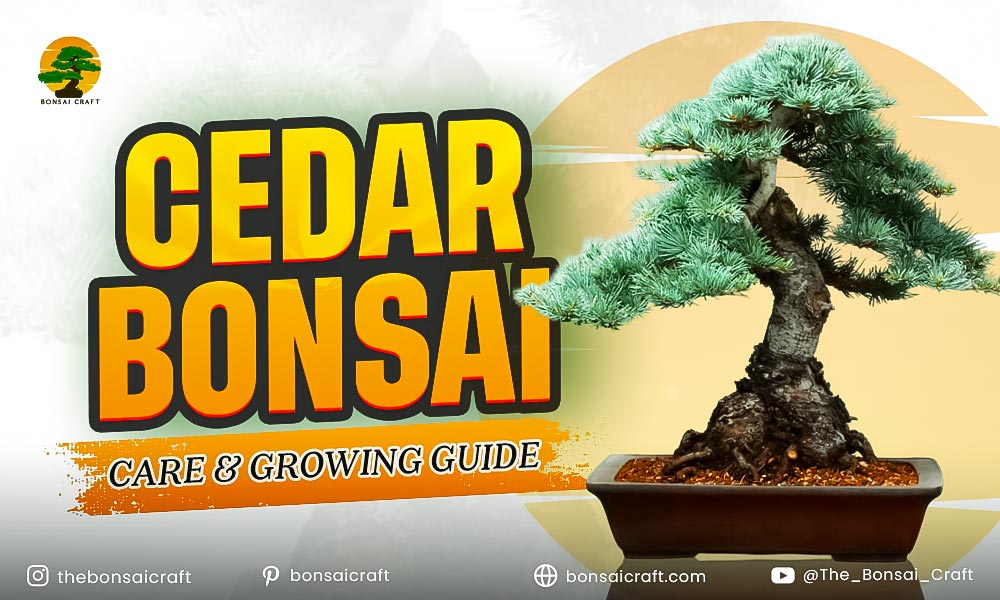
Bonsai gardening is a beautiful and meditative practice, where you create miniature trees that mimic the natural beauty of full-sized trees. The cedar bonsai tree is one of the most sought-after trees for bonsai enthusiasts due to its unique aesthetic, resilience, and striking appearance. Whether you’re caring for a Japanese cedar bonsai, Eastern red cedar bonsai, or Blue Atlas cedar bonsai, this comprehensive guide will provide you with all the insights you need to grow and maintain a thriving cedar tree bonsai.
As an expert in bonsai cultivation, I’ve spent years nurturing various types of cedar bonsai, including deodar cedar bonsai and incense cedar bonsai. In this article, I’ll walk you through cedar bonsai care, including pruning, wiring, and other essential tips to ensure your cedar bonsai tree thrives for years. Let’s explore the care requirements, styling tips, and growing techniques for cedar bonsai.
Why Cedar Bonsai Trees Are Worth Growing
Cedar trees are not only known for their durability and stunning foliage but also for their symbolism. In many cultures, cedar bonsai trees represent strength, wisdom, and resilience. Whether it’s the striking Western red cedar bonsai or the aromatic incense cedar bonsai, each variety offers unique characteristics that make them perfect for bonsai cultivation.
Growing a cedar bonsai tree can be a rewarding experience. Cedar trees have strong roots and develop an impressive, layered appearance over time, making them a favorite among bonsai artists. But cultivating a bonsai cedar tree requires patience, knowledge, and consistent care. From wiring to pruning and seasonal maintenance, you need to understand the specific needs of your cedar bonsai to keep it healthy and flourishing.
This guide is packed with expert advice on growing and styling cedar bonsai trees, including specific tips for each variety, such as blue atlas cedar bonsai, cedar elm bonsai, and others. Let’s dive into the details and start growing your perfect cedar bonsai tree.
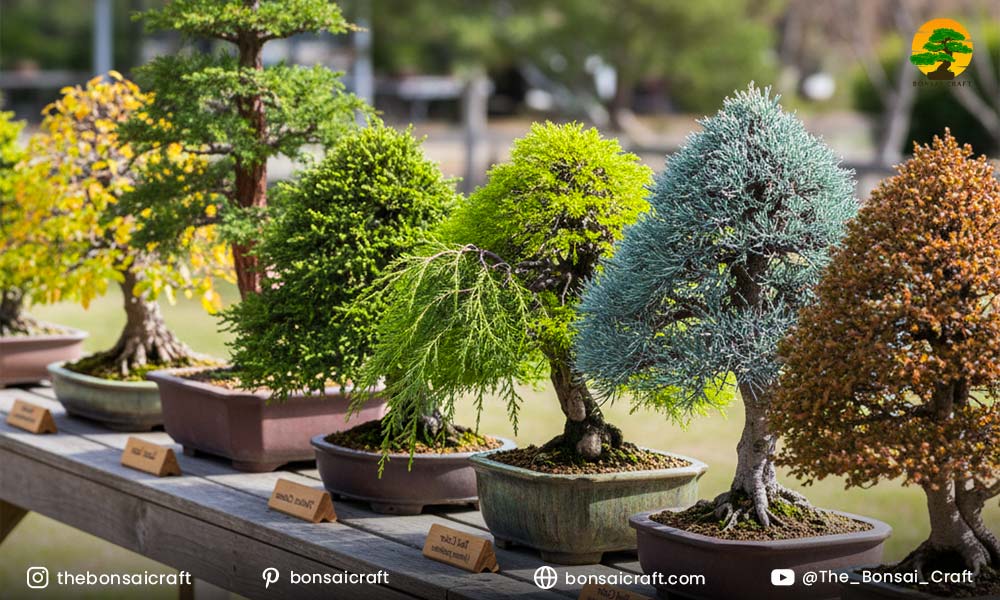
Types of Cedar Bonsai Trees: Which One is Right for You?
Just like with other types of bonsai plants, you need to know what species of cedar trees are used in cedar bonsai cultivation. Understanding the various types is critical, as every species is different in certain ways, and they all require different kinds of nurturing which will impact your choice of the tree.
Eastern Red Cedar Bonsai
Since its leaves are scale-like, the Eastern red cedar bonsai (Juniperus virginiana) is one of the fastest growing species of bonsai. The tree has distinctly red foliage, enabling it to stand out from the competition. Alongside its strong, upright growth and hardy, adaptable nature it is the perfect plant for beginners.
Blue Atlas Cedar Bonsai
Known for its striking blue-grey foliage, the Blue Atlas cedar bonsai (Cedrus atlantica) is a beautiful and robust choice. Its symmetrical, conical shape makes it a great option for traditional bonsai styling.
Japanese Cedar Bonsai
The Japanese cedar bonsai (Cryptomeria japonica) is highly prized for its delicate texture and appealing green color. Known for its fast growth and resilience, this tree can be shaped into various bonsai styles.
Red Cedar Bonsai
The red cedar bonsai (Cedrus deodara) is known for its graceful, drooping branches and soft, blue-green needles. It’s perfect for those who want a bonsai cedar tree with a distinct, flowing appearance.
Western Red Cedar Bonsai
The Western red cedar bonsai (Thuja plicata) features dense, scale-like leaves and an aromatic fragrance. This variety is ideal for those looking for a slow-growing bonsai tree with a rich, natural look.
Deodar Cedar Bonsai
The Deodar cedar bonsai (Cedrus deodara) has attractive, soft green needles and a tall, upright growth habit. It is a highly resilient tree, suitable for all bonsai enthusiasts.
Incense Cedar Bonsai
The incense cedar bonsai (Calocedrus decurrens) is known for its distinctive aromatic bark and soft, fern-like foliage. This species is unique due to its fine foliage texture, making it an excellent choice for artistic styling.
Cedar Elm Bonsai
The cedar elm bonsai (Ulmus crassifolia) is not technically a true cedar but offers beautiful leaves that turn yellow in autumn. It has a fine texture and is perfect for those looking to experiment with a cedar tree bonsai that is not a true cedar.
Cedar Bonsai Care Basics
Now that you have an idea of the different types of cedar bonsai trees, it’s time to explore the essential care practices that ensure your tree remains healthy and vibrant.
Sunlight Requirements for Cedar Bonsai Trees
Cedar bonsai trees generally prefer full sun to maintain strong growth and healthy foliage. Ideally, your cedar bonsai tree should receive at least 6 hours of direct sunlight per day. However, be mindful of the temperature. While cedar bonsai trees love the sun, they can suffer from sunburn if exposed to intense midday heat.
- For indoor bonsai, place your cedar bonsai near a south-facing window.
- Blue Atlas cedar bonsai and Deodar cedar bonsai trees particularly thrive in bright, indirect light.
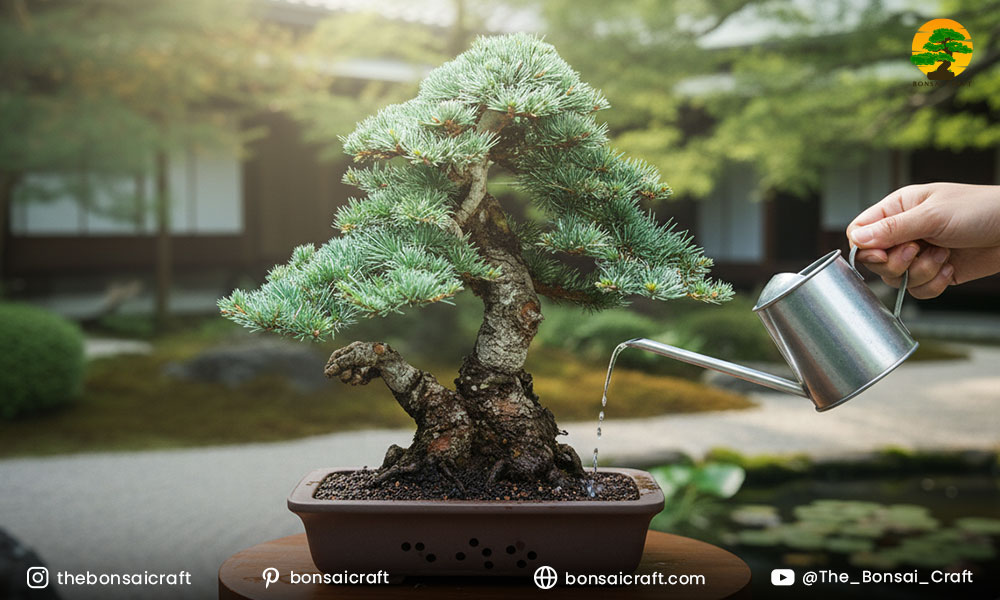
Watering Cedar Bonsai Trees
Cedar bonsai trees need consistent moisture but do not tolerate waterlogged soil. It’s important to allow the soil to dry out slightly between watering.
- Water when the topsoil feels dry: Test the soil with your finger to check its moisture level.
- Ensure the pot has good drainage: Use well-draining bonsai soil to prevent water from sitting in the bottom of the pot.
During the growing season (spring and summer), cedar bonsai trees need more water, while in the winter, reduce watering as the tree goes into a dormant state.
Soil Requirements for Cedar Bonsai Trees
For proper growth, cedar bonsai trees require a well-draining soil mix that provides adequate aeration to the roots. A mix of akadama, lava rock, and pumice works well for cedar tree bonsai. This mixture ensures good drainage and helps prevent root rot.
- pH Level: Cedar bonsai trees prefer slightly acidic to neutral soil (pH 6.0 to 7.0).
- Soil Composition: Choose soil that retains moisture without being too compact.
Fertilizing Cedar Bonsai Trees
Fertilizing your cedar bonsai tree during the growing season is important for encouraging strong growth and vibrant foliage. Use a balanced liquid fertilizer or slow-release granular fertilizer once every 4–6 weeks.
- Avoid over-fertilizing: Too much fertilizer can lead to weak, overly lush growth.
- No fertilization in winter: During the dormant season, reduce fertilization to allow the tree to rest.
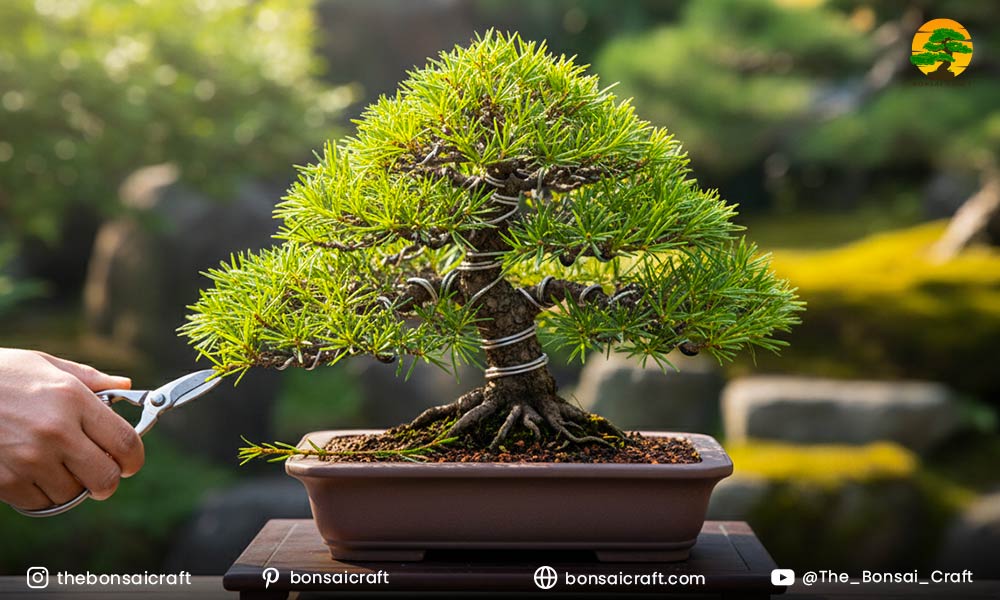
How to Bonsai a Cedar Tree: Wiring and Pruning Tips
Pruning and wiring are crucial for shaping your cedar bonsai tree. The right techniques will help your tree develop a beautiful, well-proportioned shape.
When to Wire an Eastern Red Cedar Bonsai
Wiring is best done in early spring when the branches are still flexible but not yet actively growing. You can wire the branches to train them into the desired shape. Avoid over-wiring as this can damage the delicate branches.
- Use aluminum wire: This is the most commonly used wire for bonsai because it is easy to manipulate and doesn’t damage the branches.
- Monitor the wire: Check the wire regularly to ensure it doesn’t cut into the bark.
How to Bonsai a Cedar Tree from Seedlings
Starting with cedar bonsai seedlings gives you full control over the tree’s shape. Here’s how to begin:
- Scarify the outer shells of the seeds. The outer shells of cedar seeds are tough and can be scarified for proper germination.
- The outer shells must always be placed in water and soaked for at least a day, and then they can be placed in a prepared bonsai soil.
- As soon as the seedlings have roots and are 3-4 inches in height, they can be placed in separate pots, where they can be carried out with basic wiring and pruning.
Pruning Your Cedar Bonsai Tree
Pruning is essential for maintaining the shape and health of your cedar bonsai tree. Follow these tips:
- Prune dead or damaged branches: Remove any branches that are dead, diseased, or weak.
- Thin out excess growth: This helps to reduce overcrowding and allows more light to reach the inner branches.
- Stop pruning in late fall: Avoid excessive pruning after the growing season has ended to allow the tree to rest.
Repotting Cedar Bonsai Trees
Looking after the roots is essential, and is the reason cedar bonsai trees are not be root bound. Cedar bonsai trees require repotting every 2-3 years.
- Best time to repot: The season closest to the beginning of the growing season is the best time to repot. The start of spring is the first time to do this.
- Prune roots: Sport cables supporting the cedar are broken, or roots that have completed a circle need to be cut to promote growth. Pruning aids in the repotting process.
- Fresh soil mix: Old, unhealthy soil should be removed and replaced with freshly drained soil appropriate for bonsai trees.
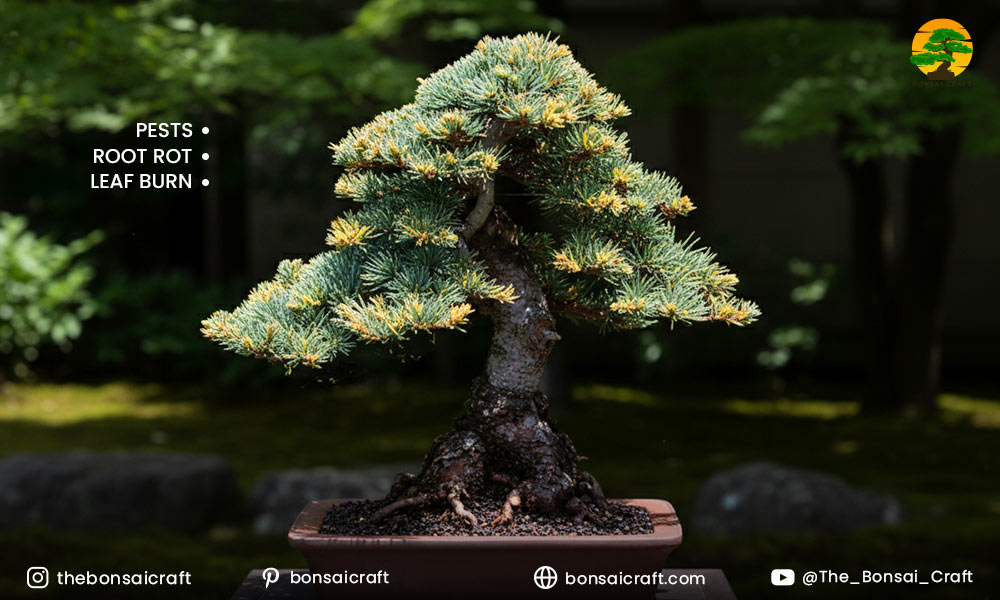
Common Issues with Cedar Bonsai Trees
Like all bonsai trees, cedar bonsai trees can face certain challenges. Some common problems include:
- Pests: Aphids, spider mites, and scale insects can infest your cedar tree bonsai. Treat with organic insecticides like neem oil.
- Root rot: Ensure your pot has proper drainage and avoid overwatering to prevent root rot.
- Leaf burn: Cedar bonsai trees can suffer from leaf burn if exposed to excessive sunlight. Provide shade during the hottest part of the day.
Conclusion: Enjoying Your Cedar Bonsai Tree
Caring for a cedar bonsai tree can be a rewarding experience, and with the right knowledge, your tree can thrive for many years. Whether you’re nurturing a blue atlas cedar bonsai, Eastern red cedar bonsai, or incense cedar bonsai, following the care and styling tips outlined here will ensure that your bonsai cedar tree remains healthy and beautiful.
Expert Tip: Cedar bonsai trees may take time to develop, but with patience and regular care, your tree will grow into a stunning work of art. Don’t be afraid to experiment with different shapes and styles to showcase the natural beauty of your cedar bonsai tree.
FAQs About Cedar Bonsai
How often should I water my cedar bonsai tree?
Water your cedar bonsai tree when the top layer of soil feels dry. Ensure the pot has proper drainage to avoid root rot.
When is the best time to prune my Eastern Red Cedar Bonsai?
The best time to prune your Eastern red cedar bonsai is during the growing season, preferably in spring, when new growth begins.
Can I grow a cedar bonsai tree from seeds?
Yes, you can grow a cedar bonsai tree from seeds. Scarify the seeds, soak them, and plant them in well-draining soil to encourage germination.
What soil is best for cedar bonsai trees?
Use a well-draining mix of akadama, pumice, and lava rock for your cedar bonsai tree. This mix promotes healthy root growth and prevents root rot.
How do I stop my cedar bonsai tree from growing too tall?
Should your cedar bonsai tree be too tall for your liking, regular pruning of the top growth and careful wiring will help encourage the branches downward.
